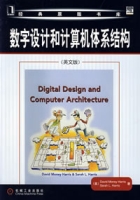本書採用了一種獨特的現代數字設計方法,先介紹數字邏輯門,接著講述組合電路和時序電路的設計,並以這些基本的數字邏輯設計概念為基礎。重點介紹如何設計實際的MIPS處理器。另外,在全書的實例中運用Verilog和VHDL展示基於CAD的電路設計方法和技術。通過本書,讀者能夠構建自己的微處理器,並能夠自頂向下地理解微處理器的工作原理。
基本介紹
內容提要,編輯推薦,作者簡介,目錄,
內容提要
本書採用了一種獨特的現代數字設計方法,先介紹數字邏輯門,接著講述組合電路和時序電路的設計,
並以這些基本的數字邏輯設計概念為基礎。重點介紹如何設計實際的MIPS處理器。另外,在全書的實例中運用Verilog和VHDL展示基於CAD的電路設計方法和技術。通過本書,讀者能夠構建自己的微處理器,並能夠自頂向下地理解微處理器的工作原理。

本書基於作者豐富的教學和實踐經驗,以幽默的寫作風格展示了最新的數字設計方法。
編輯推薦
本書採用流行的數學法,從計算機組成和設計向下至更精細的層次,詳細展示了如何用Verilog和VHDL構建MIPS微處理器。本書為學生提供了一個很好的機會,使他們可以在現代FPGA上進行大型的數字設計,既能增長學生的專業知識,又能啟發學生運用所學知識去解決實際問題。書中通過大量示例來幫助讀者加深對關鍵概念和技術的理解和記憶。本書為英文版。
作者簡介
DavidMoneyHarris哈維瑪德學院工程學副教授。他曾經為英特爾、惠普、SUN等公司設計微處理器。
SarahL.Harris哈維瑪德學院工程學副教授。她在史丹福大學獲得電子工程博士學位,擅長計算機體系結構設計和系統設計。
目錄
Preface
Features
OnlineSupplements
HowtoUsetheSoftwareToolsinaCourse
Labs
Bugs
Acknowledgments
ChapterIFromZerotoOne
1.1TheGamePlan
1.2TheArtofManagingComplexity
1.2.1 Abstraction
1.2.2 Discipline
1.2.3 TheThree-Y's
1.3TheDigitalAbstraction
1.4NumberSystems
1.4.1 DecimalNumbers
1.4.2 BinaryNumbers
1.4.3 HexadecimalNumbers
1.4.4 Bytes,Nibbles,andAllThatJazz
1.4.5 BinaryAddition
1.4.6 SignedBinaryNumbers
1.5LogicGates
1.5.1 NOTGate
1.5.2 Buffer
1.5.3 ANDGate
1.5.4 ORGate
1.5.5 OtherTwo-InputGates
1.5.6 Multiple-InputGates
1.6BeneaththeDigitalAbstraction
1.6.1 SupplyVoltage
1.6.2 LogicLevels
1.6.3 NoiseMargins
1.6.4 DCTransferCharacteristics
1.6.5 TheStaticDiscipline
1.7 CMOSTransistors
1.7.1 Semiconductors
1.7.2 Diodes
1.7.3 Capacitors
1.7.4 CMOSandpMOSTransistors
1.7.5 CMOSNOTGate
1.7.6 OtherCMOSLogicGates
1.7.7 TransmissionGates
1.7.8 Pseudo-nMOSLogic
1.8 PowerConsumption
1.9 SummaryandaLookAhead
Exercises
InterviewQuestions
Chapter2ComMnationalLogic
2.1Introduction
2.2BooleanEquations
2.2.1 Terminology
2.2.2 Sum-of-ProductsForm
2.2.3 Product-of-SumsForm
2.3BooleanAlgebra
2.3.1 Axioms
2.3.2 TheoremsofOneVariable
2.3.3 TheoremsofSeveralVariables
2.3.4 TheTruthBehindItAll
2.3.5 SimplifyingEquations
2.4FromLogictoGates
2.5MultilevelCombinationalLogic
2.5.1 HardwareReduction
2.5.2 BubblePushing
2.6X'sandZ's,OhMy
2.6.1 IllegalValue:X
2.6.2 FloatingValue:Z
2.7KarnaughMaps
2.7.1 CircularThinking
2.7.2 LogicMinimizationwithK-Maps
2.7.3 Don'tCares
2.7.4 TheBigPicture
2.8CombinationalBuildingBlocks
2.8.1 Multiplexers
2.8.2 Decoders
2.9Timing
2.9.1 PropagationandContaminationDelay
2.9.2 Glitcbes
2.10 Summary
Exercises
InterviewQuestions
Chapter3SequentialLogicDesign
Chapter4HardwareDescriptionLanguages
Chapter5DigitalBuildingBlocks
Chapter6Architecture
Chapter7Microarchitecture
Chapter8MemorySystems
AppendixADigitalSystemImplementation
AppendixBMIPSInstructions
FurtherReading
Index

